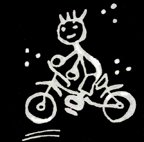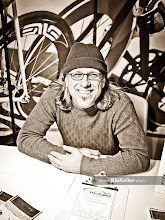 Well the inevitable question of who what how and why will this not be another failed attempt at bringing velodrome racing to Sacramento. This may be a bit long winded for the TweetyMyFace crowd, but hang in there and I will get to the point….eventually.
Well the inevitable question of who what how and why will this not be another failed attempt at bringing velodrome racing to Sacramento. This may be a bit long winded for the TweetyMyFace crowd, but hang in there and I will get to the point….eventually.In 2003 I started riding one of those goofy fixed gear bikes that the messenger kids were riding because they are simple to maintain, easy to lock up at the local watering hole, and old school race culture says you should ride your first 1000k of the off season on a track bike with an easy gear to develop a supple spin. A couple years later Mary Maroon was all jazzed up about track racing at Hellyer Park and started talking about building a track in Sacramento. I figured if we were gonna do this I better get a race bike and make a trip or two down to San Jose to check it out. I went to my first beginners session during the winter of 2006-2007. One taste and I was hooked. A few sessions later I got my wife-to-be hooked too and we started going to as many beginners’ races as we could.
It wasn’t long before we started hearing about these big money races called omniums or velodrome challenges. These are events with $10-20,000 in prize money. Several events are run over the course of two to three days with racers going for individual prizes as well as prizes for the overall most consistent results throughout the entire weekend. There are usually three to four of these on the west coast during the summer. It’s pretty much the same core group that travels to and compete in these events. Having a background in music and having done five national tours that sounded like my kind of circus. The problem is, or was, to ride in these races you are required to be ranked as a top level amateur or professional track rider. So, we set about racing and training to get our upgrades so we could make the scene. And make the scene we did.
Fast forward two years to our preparation for the big races of 2009. The group that runs the big race at Hellyer, The American Velodrome Challenge, holds a spring series called Get Ready for Summer. Of course we jumped at the opportunity to go on sunny spring days to get ready for summer racing. We had a blast doing the series, raced the big event, then went up to Portland for the Alpenrose Velodrome Challenge. I was in an arena with raging warriors half my age…wildly passionate athletes, men AND women, who care for little more than having fun, chasing prizes, and getting to the next big race. It was sometime during that week that something clicked. I vividly remember saying to myself “this is what I want to do with the rest of my life.”
I immediately started talking to anyone and everyone that would listen about track racing and building a velodrome in the Sacramento area, all the while going about the business of preparing specifically for the 2010 track racing season. Spring finally comes, and again we are thankful to Rick Adams, Kevin Worley, and Matt Martinez for giving us the opportunity to get ready to race the big show. We planned to expand our summer tour up to Redmond, Washington for the FSA Grand Prix. Sometime during the keirin heats at the 2010 American Velodrome Challenge the other light came on. Those sneaky devils! The Get Ready for Summer races are as much, if not more, an opportunity for these guys to fine tune their act as much as it is a chance for us to get some much needed track time. This got me to thinking about how much work goes into running a successful velodrome program. It became immediately and alarmingly apparent that building a track is the easy part. What makes the tracks we’ve raced special are the people and their programs.
During this four year run we took advantage of most of the programs available at Hellyer on our way to qualify to race at the highest level. Since this entry is already long winded I may as well list as many as I can. To ride the track everyone is required to attend three orientation sessions. These sessions are held year round, weather permitting. There is usually a rotation of five coaches that run these sessions. The track maintains a fleet of rental bikes for folks that want to give it a try before investing in a track bike. There are low key races run on Tuesday and Wednesday nights from April through September where new racers can earn upgrade points to race the bigger events as well as a chance for the fast guys and gals to get some mid week intensity. Riders of all levels, and this is what makes it socially satisfying, are mixed together in the infield and take turns racing in self seeded A.B, or C divisions. You have junior boys and girls, rank beginners, seasoned messengers, awkward roadies, and grizzled pros all mixed together and egging each other on. Then there is the Friday night series. These are higher category races that draw more spectators and are sponsored by local clubs that bring refreshments and volunteers to help out. These races have 4-5 referees where as the low key racing usually has only one or two which includes the promoter. Two times a week there are junior only sessions run by parents and a few veteran racers. One group is for the little 10-13 year olds, and the other is for the bigger faster kids. There are also a half dozen training sessions throughout the week that are run by track supervisors that may also include a motorcycle pacer to keep the speed high. Then there are a series of match sprint racer where the big and burly boys and girls race each other, one on one, over short distances. And last but not least there is the Velodrome Challenge, and Masters and Elite State Championships. Oh, and let’s not forget the annual ladies camp run by Beth Newell and Annabel Holland which is focused on getting more women racers involved with track racing. The glue that holds it all together is a non-profit corporation with a 10-12 member board of directors. Whew! I hope I didn’t leave anyone out.
So the best scenario is to have a healthy non-profit association that runs our racing and programs, a municipal property run and policed by the parks commission, and a constant and varied in flux of private funding and sponsorship. We have written and filed Articles of Incorporation with the Secretary of State. From there we will get a tax id and open a bank account. We have secured seed money to launch our website, seek the advice of lawyers and accountants, and file for non-profit status with the IRS. We are working on getting a small fleet of junior bikes so we can start recruiting kids, get them comfortable riding fixed gear bikes, and take them on field trips down to Hellyer to meet and ride with kids their age on a real track. I built my roller racing rig so we can start promoting races while raising awareness and more seed money. We also have plans to run a summer twilight series where we will do match sprints, chariot races, and time trials on fixed gear bikes. We have been talking to Kevin McCarty, planning staff and planning commissioners and have scheduled a meeting at City Hall with my old high school mate Kevin Johnson. If the city is not willing to play nice or makes things too difficult we have plan B to build on private land a few miles south of Sacramento.
My personal qualifications include being a USA Cycling Level II coach in good standing for five years which includes 3 separate weeks of training at the Olympic Training Center in Colorado Springs I've been a shop bike mechanic for eight years. I’ve ridden and raced many styles of cycling that include year around commuting (in 2008 I won the second highest individual miles award for May is Bike Month), freestyle street BMX, several double centuries including a California Triple Crown, completing the Death Ride, winning Eppie’s Great Race, competing in over a hundred road races and criteriums, competing in close to a hundred track races, and participating in local race and club rides. The more I talk about building this velodrome, the more folks are looking to me for direction. I have managed to infiltrate the American track racing scene from the infield. I’m friends with the promoters and associations that run the big West Coast races. I have a good relationship with the Hellyer crew and can turn to them for mentorship. I am friends with several past and current national and world champion trackies. I have earned the respect and mutual admiration of my peers. I am willing to build this grassroots association one relationship at a time until we have so much momentum that the actual construction of our track becomes inevitable. This is where all other attempts have failed. They failed to recognize that a movement is made not of concrete, wood and steel, but of people that are unafraid to dream. Come to the Hot Italian and watch or race. Share in the good times, great food and camaraderie. And see if you don’t come away with an insatiable itch for more.
I will close with the mission statement from our Articles of Incorporation:
This corporation is a nonprofit Public Benefit Corporation and is not organized for the private gain of any person. It is organized under the Nonprofit Public Benefit Corporation Law for charitable purposes.
B. The specific purpose of this corporation is to develop and operate a velodrome for the use and benefit of the communities in the greater Sacramento region.
Charitable and educational programs will include:
a)bicycling safety and education, with an emphasis on junior development
b)the promotion of healthy lifestyles and fitness
c)the promotion of local, regional, and national sporting events

.jpg)








